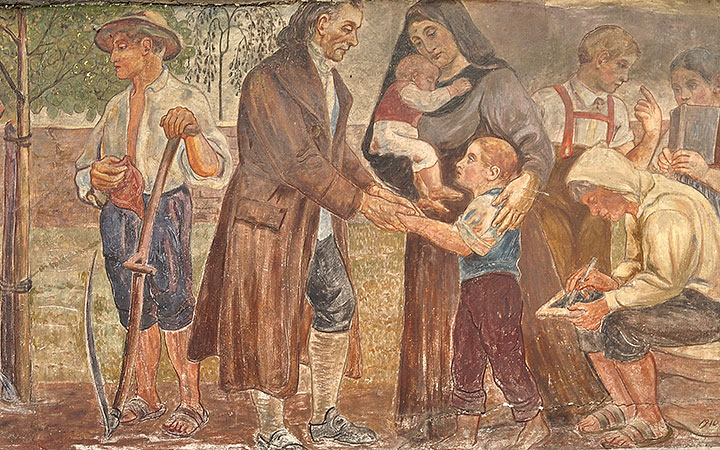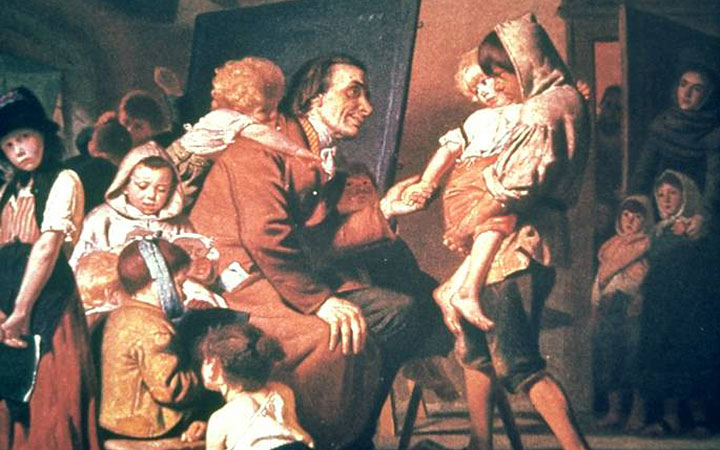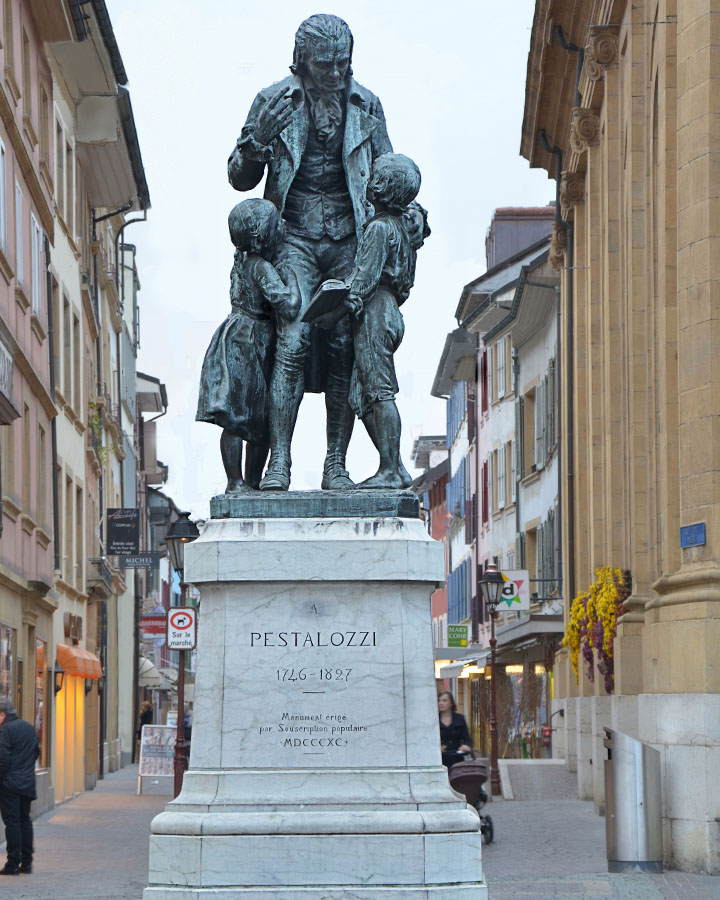Johann Heinrich Pestalozzi
A Swiss educational reformer with a radically unique teaching method
| June 2012Imagine a school where children attend 10-hour-long classes, six days a week. Where students teach each other and there are no marks or exams. Children work with saws, hammers, and planes. They operate lathes, a printing press and a bookbindery. Weekends are for hiking (children must have memorised the maps and collected the equipment in advance), swimming, and ice-skating. Core subjects include Chemistry, Physics, Zoology, and Botany.
This school was the brainchild of the Swiss educational reformer Johann Heinrich Pestalozzi (1746–1746). Pestalozzi believed in providing public education for poor children. He insisted that every child is innately educable and deserves to be raised as a contributing member of society. And he had actions to match: Pestalozzi took poor children into his own home, and eventually created the Yverdon School.
The only remains of this dream school is a small museum in a castle in Yverdon, Switzerland, but Pestalozzi’s life work still influences our understanding of children today.
Johann Heinrich Pestalozzi: a man of the heart
An unlikely misfit in society, homely and unassuming, Pestalozzi was a man of the heart more than the intellect. He took the ideas of Enlightenment philosopher Jean-Jacques Rousseau (1712–1712) fresh from his pen and put them to the test, expanding and refining them through trial and error. Despite perpetually tottering on the verge of poverty, he conducted a lifetime of ventures in education with contagious enthusiasm and vision.
The boy Pestalozzi got off to a rough start in life. Seven children were born in his parents’ first eight years of marriage; four of them died during the same period. His father, too, died when Pestalozzi was five, and the remaining three siblings were raised by their mother and a devoted maid. Their love kindled a flame that Pestalozzi was to pass on in later years as a housefather and teacher, a love which was as important to his success with children as his methods themselves. At the same time, his worried guardians so strictly sheltered and limited the boy that he was slow to acquire the skills of other children his age, and he was teased for his awkwardness. When as an adult he pondered the ideal recipe for educating children, he came to conclude that his own childhood had lacked some vital ingredients: freedom to explore one’s interests, and to observe and learn from the natural world.
For children are your riches; and upon their turning out well or ill depends the whole order of their father’s house.
Agitating for the unschooled of Zürich
The economic straits of Pestalozzi’s family from early on made him painfully aware of the ills of society and its need for remedy. He studied theology at the University in Zürich, then went into law. But his studies were interrupted. The city was astir with the ferment of the times that seeded the French Revolution, and the status quo began to show cracks. Zürich in the mid-1700s was governed by a few elitist families; ordinary citizens lacked basic rights. Pestalozzi joined a patriotic group of socially-minded university students who met privately to study ancient and modern philosophers under the leadership of a favourite instructor, Jakob Bodmer. Defying censorship, the group published a magazine airing their reformist views. Pestalozzi himself agitated vigorously for a fairer legal system for the unschooled local inhabitants, who suffered consistent repression under the high-handed ruling class. But his outspokenness came at a price: his political activism unnerved the city council, and cost him its support for his future work.
In an idealistic zeal for a life close to nature inspired by his studies of Rousseau, Pestalozzi broke off school and started up his own farm at the Neuhof, an estate in the village of Birr not far from Zürich. Progressive thought of the day proposed that improved agricultural practice would further a sound economy. As Pestalozzi knew nothing of farming, he undertook an agricultural apprenticeship for several months and became acquainted with the latest methods of cultivation. At the age of twenty-three, the university drop-out married the wealthy and beautiful Anna Schulthess, much against the wishes of her upper-class parents. Anna joined her new husband on his farm, where he was to spend nearly thirty years, first experimenting in agriculture, then pursuing social reform through education. Pestalozzi eagerly absorbed Rousseau’s newly published Emile, a book that radically challenged contemporary ideas on raising children (so much so, in fact, that the French parliament ordered it burned, and its author narrowly escaped arrest).
A child is not an adult
Not that the ideas put forth in Emile were all new – they had been fermenting quietly for centuries. Already in the fourth century B.C. the Greeks developed lofty ideals of educating for citizenship, but these had sunk into near oblivion. Plato, for instance, already advocated compulsory universal education and saw play as essential to a child’s development. He also held that education is useless if it does not impart virtue. The teacher’s task was not to put knowledge into empty vessels, but to help pupils go from ‘becoming’ to ‘being’; in Plato’s words, ‘the power and capacity of learning exist in the soul already.’ Rousseau expressed a similar viewpoint when he termed man a ‘noble savage,’ meaning, man is born good, but is easily corrupted by society. Therefore children ought not be taught in schools or classrooms, but tutored in a moral environment close to nature (books must not be introduced before the age of twelve). Parental involvement should be strong as well. Rote memorisation and teacher punishments deter learning; the student’s natural curiosity should be the force arousing to discovery. Rousseau – followed by Pestalozzi, Froebel, and Montessori – recognised what western civilisation had largely forgotten since Plato’s time, that a child is not an adult. Childhood is a necessary phase of healthy human development and must be nurtured. As he read Emile, Pestalozzi found himself resonating with Rousseau’s concepts.
Before long, the Pestalozzis had a son of their own, and little Jaqueli helped prove – or disprove – many of his young father’s germinating ideas. But his son was not the only material to hand for his investigations. Taking destitute children into what became a house for the poor at Neuhof and caring for them, Pestalozzi fine-tuned Rousseau’s hypotheses into workable methods that could be applied in the classroom. Pestalozzi wanted schooling to become relevant to the working class by preparing children for real life. Heart, hand, and head – all three must be educated as of equal value – not just the intellect. Therefore at Neuhof he trained children in manual labour – spinning, weaving, and farming – alongside their studies. Rousseau postulated that the child is like a flower that should grow spontaneously and naturally in the wild. Pestalozzi sought to reconcile Rousseau’s emphasis on individual freedom with his own significant recognition that, for best results, the flowers need not only sun and rain, but pruning and weeding.
Pestalozzi gains recognition
Despite the opposition and setbacks Pestalozzi faced throughout his life, (partly due to his own lack of organisational skills) visitors to his schools gave favourable and even astounded reports of the work he accomplished with his pupils. Through application of his theory of Anschauung (sensory experience of concrete objects before learning through words) Pestalozzi’s students progressed in art, maths, reading, and writing far more rapidly than their counterparts in state schools. But due to ongoing economic shortfall that kept him near bankruptcy, his institution at Neuhof was closed down in 1779.
Although it never brought him much money, Pestalozzi remained at Neuhof writing, producing among other works his first masterpiece, Leonard and Gertrude (1780). The novel tells of the reformation of a whole village through the way one mother educates her children. The book shortly made him famous throughout Europe.
Then Switzerland became the battlefield of Napoleon’s Revolutionary Wars. When the French invaded Switzerland in 1798 and set fire to the village of Stans, Pestalozzi received permission to open an institution there, and for six months cared for over eighty war-scarred and orphaned children. The house existed in direst poverty, but he presided over it in a spirit of fatherly self-sacrifice that began within a short time to transform the near-ruined youngsters. For Pestalozzi, the opportunity represented a chance to fulfil his highest dream – to research in a caring setting how children should best be educated. But before long, the government intervened. As a supporter of the ideals of the French revolutionaries (though not their extreme tactics), Pestalozzi was mistrusted by the town’s Catholic populace, and his institute was abruptly ousted in favour of a military hospital. Deeply disappointed, and with his health compromised by the intense strain of caring for the orphans, Pestalozzi was forced to recuperate in the Gurnigelbad in the Bernese Alps.
Pestalozzi was then allowed to take up a position at the Burgdorf school (1799–1799), but from the start the suspicious town authorities restricted his scope for experiment. Given just a few pupils, he nonetheless set to with zeal, putting all books away and letting the children learn from their surroundings. Within months his success with these children gained him a new respect, and he was promoted to teaching a higher class. Europeans already were acquainted with Pestalozzi the author, through his earlier publication of Leonhard & Gertrude. Now, the publication in 1801 of ‘How Gertrude Teaches her Children,’ put Burgdorf on the map as travellers flocked to observe Pestalozzi the innovative educator.
Political change in Bern led to evacuation of his institute from the Burgdorf Castle, and in 1804 it relocated to a castle at Yverdon. Here the work of educational experimentation flourished for many years as the ageing but still-vigorous Pestalozzi mentored his staff, wrote voluminously, and welcomed international visitors and trainees (visitors over the years included Fichte, Ramsauer, Herbart, Froebel, Ritter, and Dr. Mayo). Hence his ideas were blown like seeds across Europe. The life at Yverdon in its heyday was wonderfully distinctive, with students and staff living as a community within the village. Students who could not afford to pay were admitted regardless; parents were kept in touch via frequent updates from teachers. Older pupils regularly tutored younger ones; report cards were nonexistent (Pestalozzi felt students should not be compared, but evaluated as individuals); and children had opportunity to interact with local trades. The natural environment, too, figured hugely in the curriculum: long mountain hikes, swimming, skating, gardening, raising animals, and learning to work with their hands were all part of the normal bill of fare at the Institute.
For all his self-sacrifice in the cause of his ideals, Pestalozzi tended to take on more ambitious projects than he could actually manage. Worse, directing financial and staffing matters were not among his gifts. Vicious infighting between teachers caused the decline and eventual closing of Yverdon in 1825, after twenty years of existence. Retiring to Neuhof, Pestalozzi spent his last two years writing and even started to rebuild a house for the poor. He died before its completion, exhausted by continuing attacks from certain former staff members, who remained bitter enemies to the end.
Conclusion
As with most pioneers, Pestalozzi never saw a complete realisation of his dreams. But the seeds had been planted. The world had been awakened to the need for children to be allowed a childhood, and to be educated in such a way as to prepare them for real life. The nineteenth and twentieth centuries would see others follow in the great teacher’s steps, reforming education according to continually expanding perceptions of its purpose. Should Pestalozzi visit our schools nowadays, no doubt he would favour many of the changes brought about through the intervening years; others, perhaps, would surprise him. What would he say of a world where the outdoors has largely vanished beyond children’s reach, where children are put at desks earlier to study for longer hours, and where exams and report cards are the measure of a child’s success? With these things in mind, perhaps we could profit from taking time to revaluate the goldmine of Pestalozzi’s legacy.




